New for spring 2025, Rab’s Protium 27 pack is designed as a ‘do-it-all’ hiking daypack. It shares a few of the same traits as the existing Rab Aeon series of packs, but with a more progressive design and streamlined appearance.
It’s intended for multi-activity use, which might include everything from a tough mountain hike to a ridge scramble to a full day out bagging multiple peaks.
As you might expect then, it combines a sleek and efficient design with a versatile set of features and a back system that prioritises flexibility and stability over outright ventilation or plush padded comfort.
With a carrying capacity of 27 litres and simple zippered access to the main compartment, it’s aimed at younger, fast-moving hikers rather than more traditional hillwalkers, who might prefer a conventional lidded hiking backpack. (If that’s you, there is a bigger Protium 35 that fulfils that brief.) However, the smaller Protium 27 has several benefits.
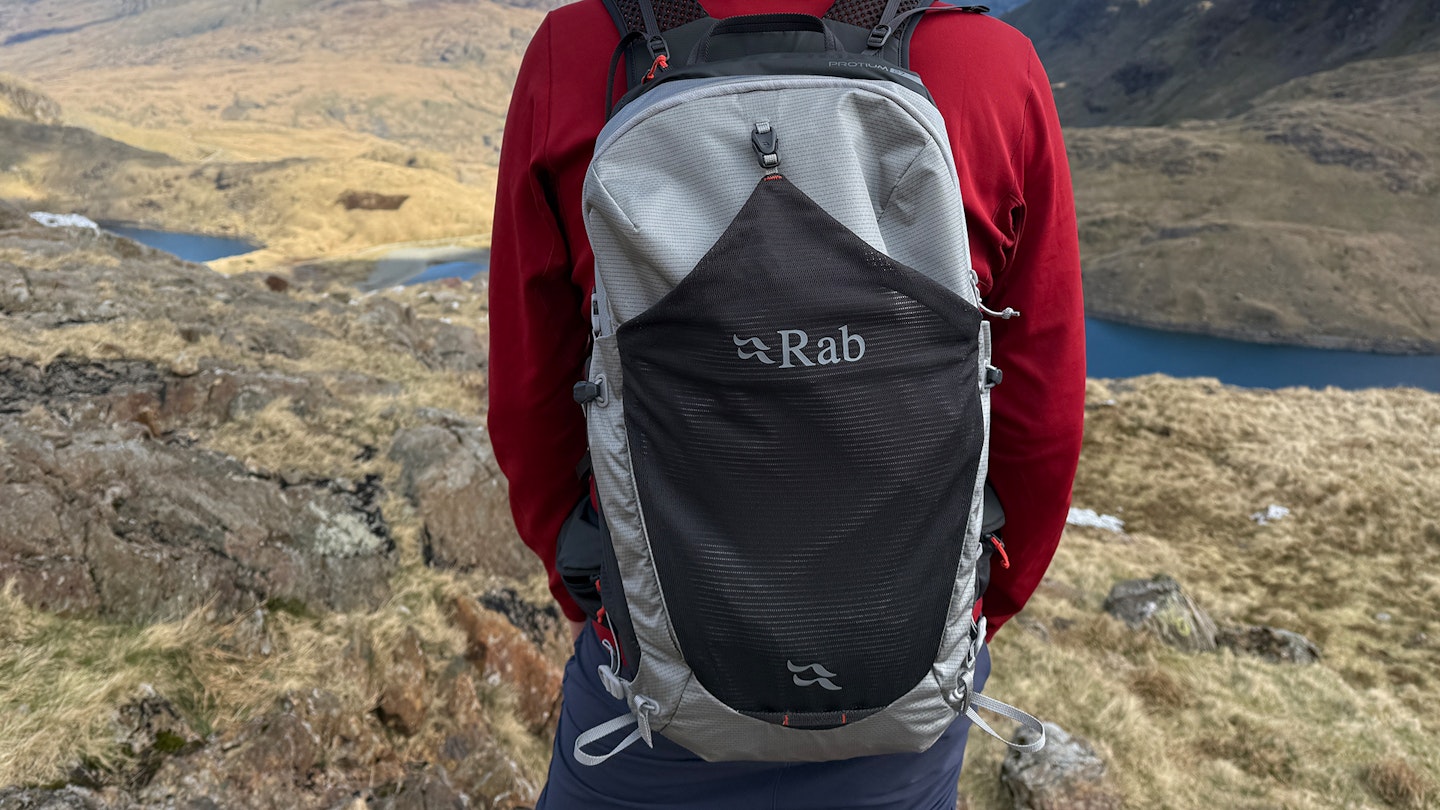 LFTO/Matt Jones
LFTO/Matt Joneswww.sportsshoes.com
Check out the women's version here.
Pros
- Adjustable fit
- Stable to carry
- Great features
- Includes a raincover
Cons
- Narrow hydration reservoir pocket
- Shoulder straps not the plushest
| RRP: | £130 / $180 |
| Weight: | 1.05kg / 2lb 3.3oz |
| Sizing (men's): | M (to fit back length 19-21in/48-53cm) and L (21-23in/53-58cm) |
| Sizing (women's): | One size (17-19in/43-48cm) |
| Volume | 27 litres |
Notwithstanding the fact that it sacrifices a bit of packing space, it’s significantly lighter, while still being durable enough to handle sustained mountain use.
There are also plenty of practical pockets as well as various concessions to all-day carrying comfort, such as an adjustable back system and generously padded hip fins. So, this is certainly no spartan, minimalist pack.
On test, we found it worked well for longer days out, since it is roomy enough to carry plenty of gear. For example, we had it out in early spring, when there was still a dusting of snow on the tops, and summit temperatures were low enough to call for a big belay jacket.
The only caveat to that is that the shoulder straps start to feel a bit thin and bouncy when carrying more than 10kg or so. Overall, however, we were impressed. Bottom line? The Protium 27 is a great pick if you’re after a robust and versatile option for demanding mountain days.
Back system

This pack is available in three different sizes, to suit different torso lengths and body shapes. There’s a men’s medium (designed for back lengths from 19-21in/48-53cm) and a men’s large (21-23in/53-58cm), as well as a women’s or ND (narrow dimensions) model, designed for 17-19in/43-48cm backs.
This sizing ought to cover most bases – but in addition to that, each pack also has an adjustable back system to further fine-tune the fit. The shoulder straps are stitched to a Velcro panel, which slides up and down to enable the wearer to tweak the back length as desired.
The rest of the back panel is Rab’s Air Contour design, which consists of a plastic framesheet with air channels behind a layer of perforated foam with diamond-shaped and triangular cutouts, overlaid with mesh. The foam panel tapers considerably towards the base.
The whole system is relatively flexible, so it moves with the body. This is great for dynamic activity, but it does mean the pack frame is less rigid than some rivals, which is generally a negative in terms of load transfer. Having said that, it carries well with loads up to about 10kg.
One minor point to note is that the pack is fairly tall and narrow, similar to a traditional Alpine-style mountain pack.
This means it tends to sit quite high on your back, which can occasionally cause the top to press into the back of the neck. It’s mostly only noticeable when scrambling on steeper terrain, and isn’t a real issue, but can get a bit annoying.
Harness and hipbelt
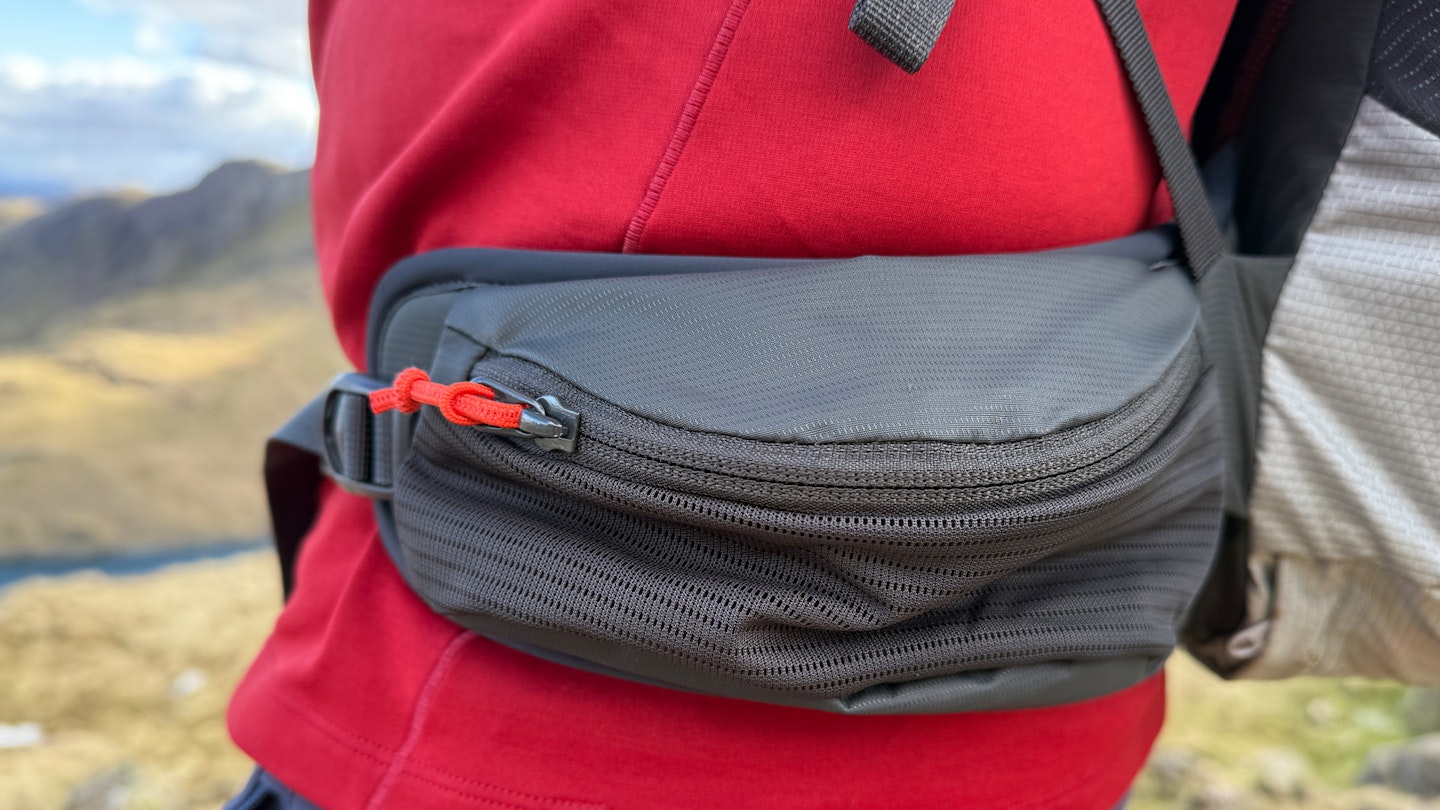
I really like the Protium 27’s long and wide hip fins, which wrap the body really well and aid overall load transfer. Despite being well-padded, they’re surprisingly cool and breathable, thanks to the use of fast-wicking mesh and perforated foam.
The belt fastens via a slim piece of nylon webbing and a plastic squeeze buckle, which can be adjusted on each side with a single pull. It’s neat, unfussy and unobtrusive. The oversized hip fins also mean you get two roomy zippered storage pockets at the waist.
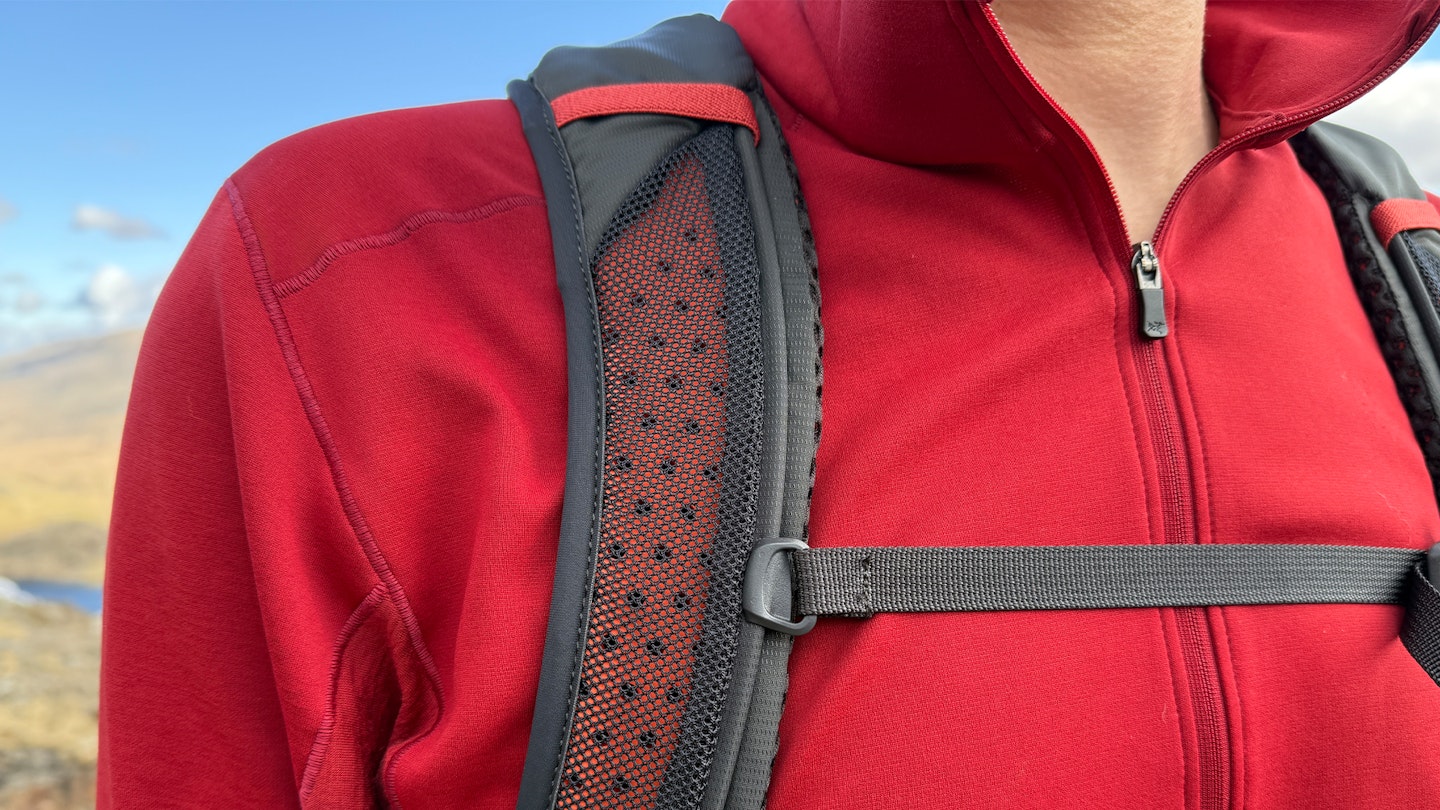
Unfortunately, the shoulder straps aren’t nearly as well padded as the hip fins, though they are just as breathable thanks to the same perforated foam/mesh combo. You do get a sliding chest strap and load lifters to help with stability and weight distribution, but the straps feel a bit thin and flimsy when carrying heavier gear.
This can lead to occasional soreness at the collarbones, though I never developed hotspots or chafing. Still, I’d like to see a bit more form and padding in future iterations of the pack.
Otherwise, the straps are nicely cut and contoured to ensure great arm mobility. The fact they’re stitched into a one-piece shoulder yoke also adds strength and durability.
Design and features
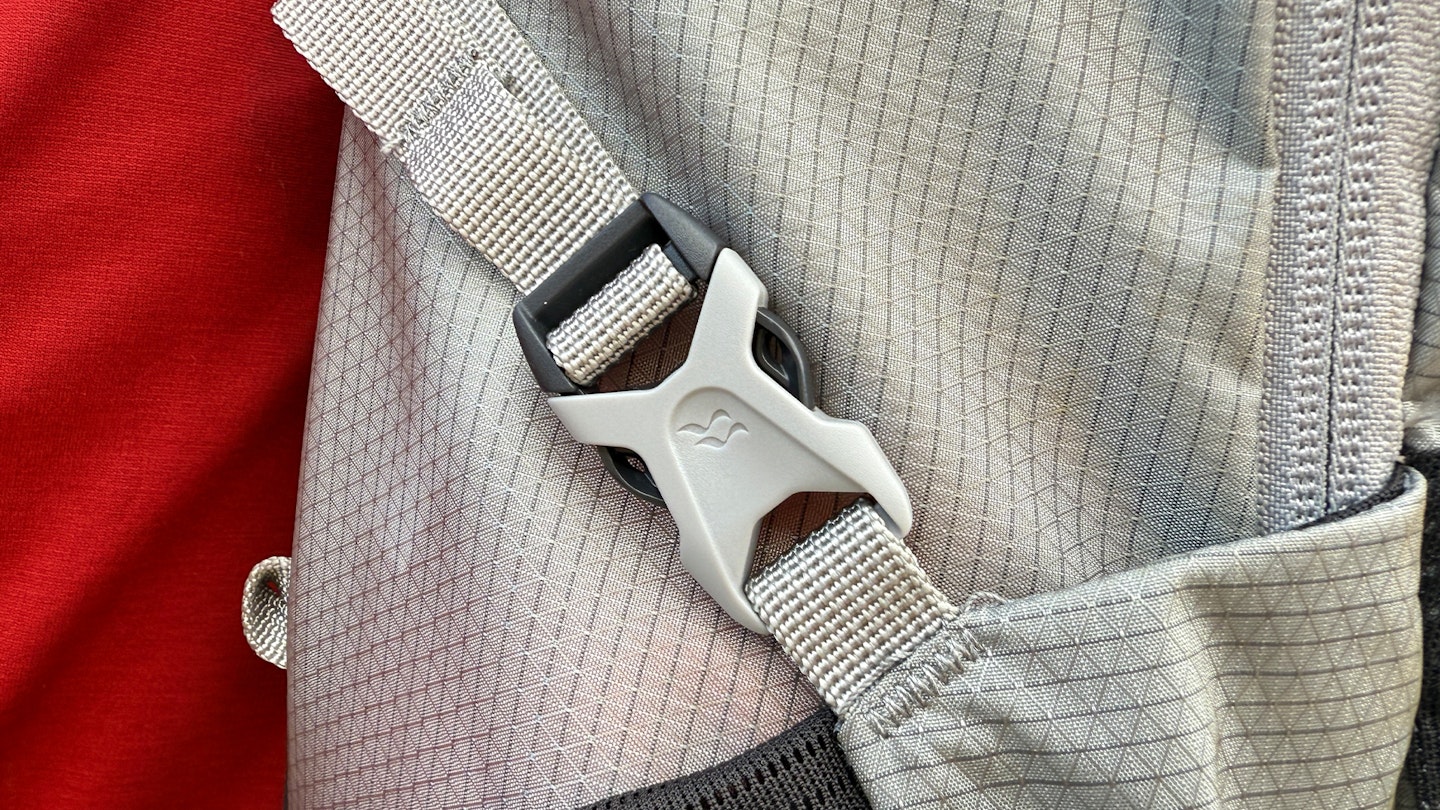
On the trail this pack feels efficient and practical. The main compartment is roomy and easy to load, and the main zip is not obstructed by the side compression straps (a bugbear with many zippered daypacks). There’s a zippered hanging mesh pocket inside the pack.
It’s hydration compatible, too, though the pocket for your water bladder is accessed externally, behind the back panel. This is much less faff when refilling and enables you to run your drinking tube over either shoulder.
Unlike other external hydration designs, there’s also enough space to prevent a full bladder from pressing against the back panel and causing barrelling. That said, the top opening is pretty tight, so depending on which size and type of hydration reservoir you have, sliding it inside might be a struggle.
Other storage options include an external zippered pocket with a key clip, and two deep side pockets with durable micromesh. These will securely accommodate a variety of different water bottles or flasks.

The front panel has a deep stretch mesh pocket with a top buckle that is perfect for stashing on/off layers. Double attachment loops at either side of the pack’s base can hold trekking poles or ice axes, with upper bungees to hold them securely.
The base of the pack also hides a pocket with a raincover. While we’d always recommend using dry bags to store your hillwalking kit, this is a nice extra that gives you an added layer of weather protection on changeable mountain days – and is a feature that even some of the best hiking daypacks lack, or which are cheekily sold as a separate add-on.
Given all these features, it’s no surprise that the Rab Protium 27 is no featherweight. Still, it tips the scales at just over a kilo, which gives it a good volume-to-weight ratio.
Of course, you can save grams if you go for a more minimalist 20-25 litre daypack, but for big days out, the added carrying capacity of the Protium 27 will save a lot of hassle when it comes to packing and rummaging.
Sustainability

Rab is very transparent about the sustainability of its products thanks to the recent introduction of its ‘material facts’ table. This gives prospective buyers a clear breakdown of all the recycled content in its products, as well as PFAS content and manufacturing origins (including the use of renewable energy).
The table for the Protium 27 reveals that 46% of the pack’s total fabric content is recycled. This breaks down into 29% recycled material for the main fabric, 30% for the secondary fabric, 86% for the liner and 82% for the raincover. In addition, there is some recycled content in the components (9%) and trims (2%). All elements are free from PFAS chemicals.
As a brand, Rab has also been a member of the Fair Wear Foundation (FWF) since 2020. It’s currently classed as a ‘leader’ by that organisation (the highest award under the criteria of their annual Brand Performance Check, scoring an impressive 76/100 overall).
Price and competition
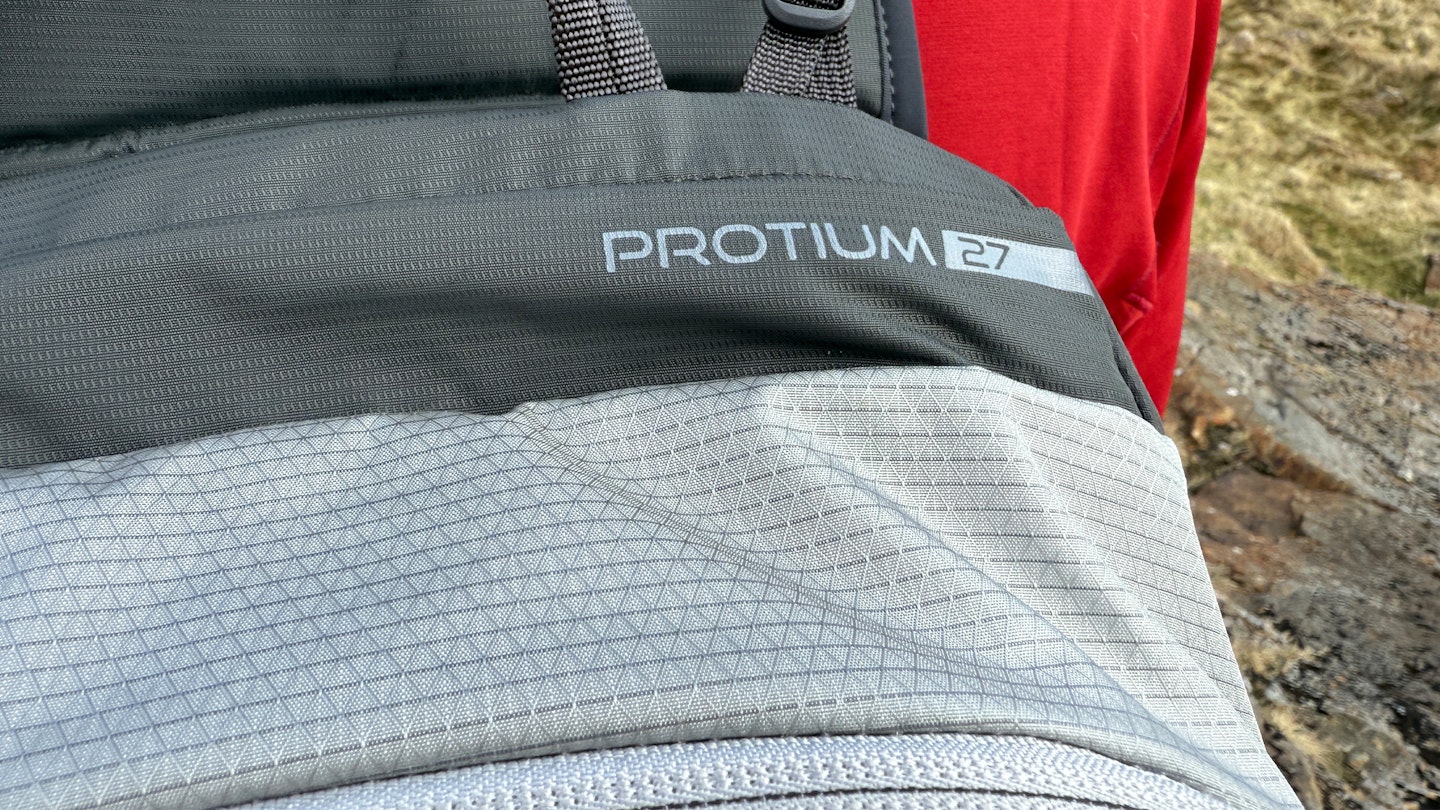
At £130, the Protium 27 seems fairly priced for a technical daypack, particularly given its slightly larger volume compared to rivals like the Osprey Stratos 24/Sirrus 24 (£155), Talon/Tempest 26 (£135) or the Gregory Zulu/Jade LT 25 (£135). Admittedly, it’s got a simpler frame and back system than those packs, but it’s also lighter overall.
On the other hand, those packs are great choices for hikers who want the best of the best when it comes to durability and comfort in a premium package, even if it means sacrificing a bit of space (and spending more cash).
Having said that, we’ve also been really impressed with the latest Berghaus packs that use their redesigned Freeflow back system. This includes the pricey Freeflow 24 (£150) and 30 (£160), but also the great value (if slightly smaller) Remote Hike 23 (£100). The Mammut Lithium 25 (£105) is also well worth a look.
Alternatively, if you’re not bothered about the extra comfort that usually comes with a dedicated gender-specific fit and/or are on a tight budget, you could also look at options like the new Vango Mitra Air 20 (£62.50) or Air 30 (£72.50), the Alpkit Presta 25 (£70) or the Sprayway Akka 30 (£75). These are all much simpler packs than the Protium 27 though.
Verdict
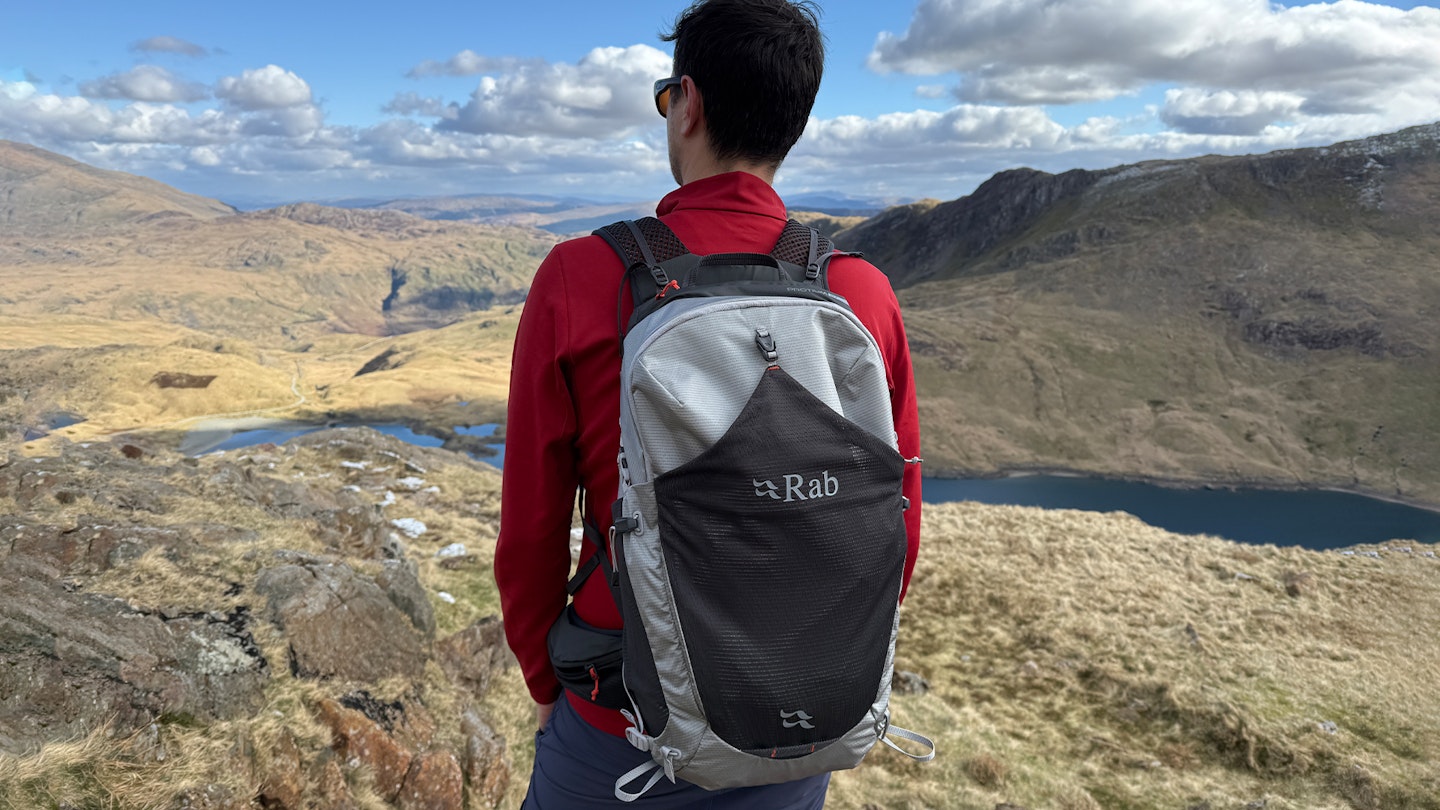
A versatile technical daypack with a stable, close-to-the-body fit that is well suited to dynamic activity. It’s probably not the right pack for ultralight minimalists, occasional hikers or those who like loads of plush padding. But if you’re after a streamlined and efficient companion for pacy summit hikes and scrambles, look no further.
Or, if you're in the market for a more versatile pack for overseas trips, check out our roundup of the best travel backpacks for a range of carrying capacities and features.
Shop this product
About the author

Matt Jones is a freelance journalist based in the heart of Snowdonia National Park, he’s a vastly experienced gear tester and self-confessed outdoor kit geek. Matt’s been one of our main gear testers for the last couple of years and is the first person we call with any complicated kit queries that need in-depth and forensic analysis.
